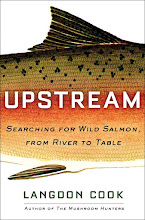Back to salal. The binomial is Gaultheria shallon. It's a member of the heath family, Ericaceae. In researching this post, I was surprised to learn that the so-called berries are not technically berries at all—they're swollen sepals. The leaves are edible, too, and were used by Native Americans. I haven't tried them myself. Salal's main economic use today is for floral displays. The foliage is harvested by brush pickers and exported all over the world.
Most hikers aren't enamored of salal. A thick understory of salal can be nearly as impenetrable to the bushwhacker as a forest of devil's club, and while the berries are much sweeter than that other iconic Northwest shrubbery—Oregon grape—they're also pulpy and nutty in a way that is unfamiliar.
It's getting late in the lowlands of the Pacific Northwest to harvest salal berries, but you're likely to still find some at higher elevations, along with Oregon grape. I gathered mine a few weeks ago and made preserves. Not quite jelly and not quite jam, this is more like a salal spread. I used a limited amount of sugar to retain the salal flavor and tartness. It will be perfect for breakfast scones and dinner cheese plates.
8 cups salal berries
2 cups water
4 tbsp lemon juice, divided
1 cup sugar
1/2 pouch liquid pectin
1. Simmer the berries, water, and 2 tablespoons of lemon juice for several minutes. Mash with a potato masher. Strain through fine-mesh seive and/or cheesecloth. My yield was 3 cups.
2. Return strained berry juice to pot. Add sugar, 2 more tablespoons of lemon juice, and pectin. Bring to boil.
3. Pour into sterilized jars. Secure lids and process 10 minutes in hot water bath.
My yield was 4 half-pint jars.
Most hikers aren't enamored of salal. A thick understory of salal can be nearly as impenetrable to the bushwhacker as a forest of devil's club, and while the berries are much sweeter than that other iconic Northwest shrubbery—Oregon grape—they're also pulpy and nutty in a way that is unfamiliar.
It's getting late in the lowlands of the Pacific Northwest to harvest salal berries, but you're likely to still find some at higher elevations, along with Oregon grape. I gathered mine a few weeks ago and made preserves. Not quite jelly and not quite jam, this is more like a salal spread. I used a limited amount of sugar to retain the salal flavor and tartness. It will be perfect for breakfast scones and dinner cheese plates.
8 cups salal berries
2 cups water
4 tbsp lemon juice, divided
1 cup sugar
1/2 pouch liquid pectin
1. Simmer the berries, water, and 2 tablespoons of lemon juice for several minutes. Mash with a potato masher. Strain through fine-mesh seive and/or cheesecloth. My yield was 3 cups.
2. Return strained berry juice to pot. Add sugar, 2 more tablespoons of lemon juice, and pectin. Bring to boil.
3. Pour into sterilized jars. Secure lids and process 10 minutes in hot water bath.
My yield was 4 half-pint jars.










7 comments:
Salal, sweated sweet onion, some sorrel or oxalis and a little salt & pepper for a grilled salmon compote - best of the fall flavors
the young leaves are surprisingly tasty and easy to gather. They taste like a mild sheep sorrel. Its a spring thing. I'm slightly skeptical about consuming them by the bushel though; as there doesn't seem to be alot of info out there. I assume they contain a decent amount of oxalic acid?
AndrewM - Your fall compote just rose to the top of my menu.
chiefbellevue - Thanks for the 411. I'll be trying salal leaves next spring, though I bet you're right about oxalic acid.
I use salal leaves in my herbal antiseptic spray. If you chew a leaf, you'll find that your mouth gets very dry. That's the medicine of salal. It dries a weepy wound or sore and promotes fast healing.
Thanks for the recipe! I'm saving it for next spring. Meanwhile, what about a recipe for rose hip syrup or jam? Many years ago I spent a winter in the Argentine Andes and someone suggested I make pancake syrup from rose hips, and I followed her recipe successfully. The syrup was brilliant orange, tart, and sweet. It's been so long, I can't remember what I did. Do you have any suggestions? Thanks!
crap; i just noticed my 4 yr old comment claims that salal leaves are tasty. I MEANT OREGON GRAPE LEAVES!! sorry if anyone took my advice!
We've lived among the salal on our property for 28 years and it took me 25 to find out how useful the plant is. We've been making large batches of salal berry spread every year since. Very tasty, flavor unlike any commercial berry spread/jam. The spread has wonderful properties that firm up the bowels. There is a lady up in Nanaimo who makes salal jam commercially but she strains out all the pulp; the seeds and skin. We leave all that in and it enhances the flavor and way adds to the texture.
Post a Comment